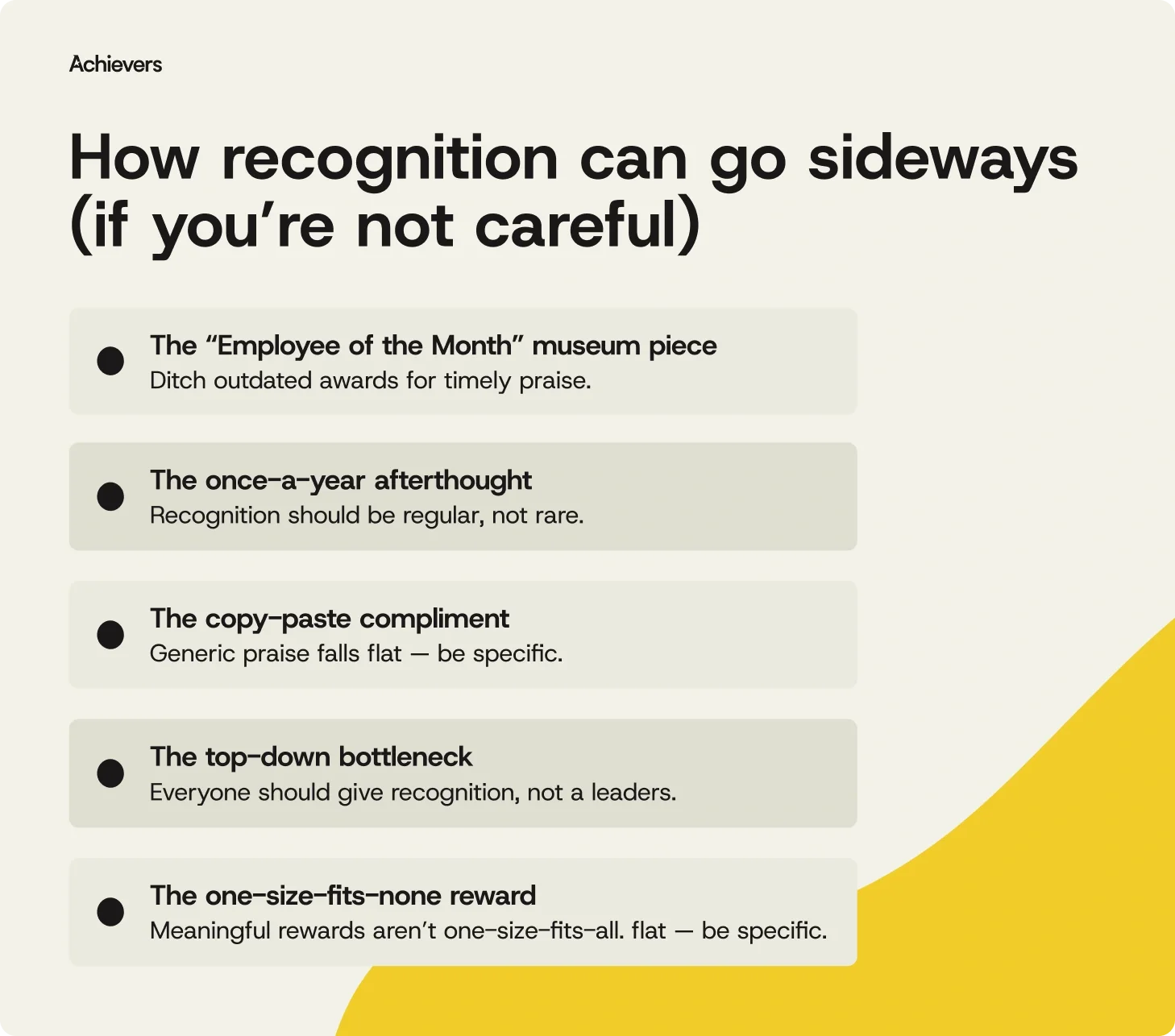Table of contents
Most people don’t quit jobs — they quit feeling invisible. When employees don’t feel seen, heard, or appreciated, no amount of free snacks or splashy perks can make up the difference. That’s where recognition comes in.
At its core, employee recognition is about making people feel valued for the work they do — and while that might sound like a “nice-to-have,” the business impact is anything but soft. When done right, recognition drives performance, boosts retention, and strengthens culture.
In this post, we’ll unpack what employee recognition really means, why it matters more than ever, and how organizations can get it right — no cheesy trophies, no awkward pizza parties, just meaningful moments that shape behavior and fuel results.
Defining employee recognition — beyond the gold star
Let’s get one thing straight: employee recognition programs aren’t about handing out gold stars for basic participation. (This isn’t kindergarten.) Real recognition is about calling out the behaviors, efforts, and wins that reflect your company’s values and drive business forward.
At its best, recognition isn’t transactional — it’s transformational. It reinforces what success looks like in your organization and motivates people to keep showing up in meaningful ways. When employees feel genuinely seen and appreciated, they don’t just do more — they do better.
Recognition done right is more than a pat on the back. It’s a strategic tool that shapes behavior, strengthens culture, and helps your people understand, “This — right here — is what matters.” And it works. Trust us.
Why recognition matters (and not just to HR)
Let’s retire the idea that recognition is just an HR “extra.” It’s not a perk. It’s an HR strategy. When employees are recognized in real, meaningful ways — not just once a year at the holiday party — they’re more engaged, more productive, and more likely to stay.
The data backs it up: frequent recognition drives measurable gains in retention, motivation, and alignment to company values. In fact, employees recognized weekly are 5x more likely to feel connected to company culture, according to the Achievers Workforce Institute (AWI). That’s the foundation of a high-performing workforce.
In short, people who feel appreciated tend to do more of the things that make a business thrive. Funny how that works, isn’t it?
The science behind the smiles
Recognition might feel good, but it’s also grounded in something more powerful than warm fuzzies: science. Here’s why it works — and why it matters:
- It reinforces the right behaviors: Recognition taps into basic behavioral psychology — reward the action, and it gets repeated. In fact, AWI data from the engagement and retention report shows that 92% of employees state that when they’re recognized for a specific action, they’re more likely to take it again in the future.
- It builds emotional connection: Feeling seen and appreciated at work boosts belonging. And when employees feel connected to their team and purpose, performance naturally follows. According to Gallup, employees who receive recognition at least once a week are 2.9 times more likely to strongly agree that they receive valuable feedback from their coworkers.
- It shapes culture, not just morale: Recognition doesn’t just lift spirits — it aligns actions with values. Harvard Business Review reports that employees who strongly agree that recognition is an important part of their organization’s culture are 3.7 times as likely to be engaged and about half as likely to experience frequent burnout.
- It drives real business outcomes: Recognition is a proven lever for results. Gallup found that employees who receive high-quality recognition are 45% less likely to leave their jobs over a two-year period.
So yes, recognition makes people smile — but it also builds connection, drives behavior, and powers business performance. The science is in. And it’s smiling, too.
Common recognition pitfalls (and how to avoid them)
Recognition has the power to shape behavior, build culture, and boost performance — but only if it’s done right. When it misses the mark, it risks feeling like noise, or worse, a chore. Here are some common recognition missteps and how to dodge them with grace (and a little common sense).

The “Employee of the Month” museum piece
There’s nothing inherently wrong with spotlighting great work — but if your approach feels like a throwback to 1998 (hello, breakroom plaque), it might be time for a refresh. People don’t want mystery awards handed down by a committee. They want timely, relevant feedback that connects to real accomplishments. Swap outdated rituals for real-time recognition that actually resonates.
The once-a-year afterthought
If your recognition efforts only surface during annual reviews or holiday wrap-ups, you’re missing the point — and the moment. Recognition needs to be frequent to be effective. When appreciation is delayed or saved for special occasions, it loses its impact. Make it part of your everyday company culture, not a calendar event. Recognition shouldn’t be rare; it should be routine.
The copy-paste compliment
Generic praise like “Good job!” or “Thanks for your hard work” is better than nothing… but just barely. Vague recognition feels transactional. Specificity is what gives praise its power. Call out the behavior, explain why it mattered, and tie it to your company’s values or goals. If the compliment could apply to anyone, it probably won’t stick with someone.
The top-down bottleneck
Recognition shouldn’t be a manager-only activity. When appreciation flows only from the top, it misses out on the peer-to-peer magic that makes recognition a cultural norm. Empower everyone — teammates, cross-functional collaborators, even customers — to recognize contributions in the moment. The more voices involved, the more authentic and sustainable your culture becomes.
The one-size-fits-none reward
Gift cards and company mugs have their place, but recognition should feel personal — not pulled from a dusty HR drawer. Meaningful rewards are those that reflect individual preferences, not just what’s easy to bulk order. Offer options. Better yet, ask people what motivates them. (Spoiler: it’s probably not another branded stress ball.)
Modern recognition: Built for humans, not handbooks
Forget the outdated playbook. Today’s recognition isn’t about policies, protocols, or hunting down that one Excel file. It’s about people — and making sure they feel seen in the moments that matter most.
Modern recognition lives where your employees do: online, in real time, and in the tools they already use. It’s fast, flexible, and built to work across teams, departments, and time zones. No red tape. No clunky admin.
With platforms like Achievers, organizations can deliver meaningful recognition and rewards — not just frequently, but effortlessly. Because recognizing great work shouldn’t be harder than doing the work itself.
Recognition that drives results
So, does employee recognition matter? Without question. But not just because it’s nice — because it works. Recognition is one of the most effective tools organizations have to shape behavior, strengthen culture, and drive real business results.
At Achievers, we’ve built a platform designed to do exactly that: help organizations deliver frequent, meaningful recognition that fuels performance and retention — without adding friction to anyone’s day.
It’s not fluff. It’s fuel. And yes, it feels good — but more importantly, it builds a stronger, more connected workforce that’s motivated to stay and succeed.
Recognition might start with a simple “thank you,” but with Achievers, it ends with measurable impact.



